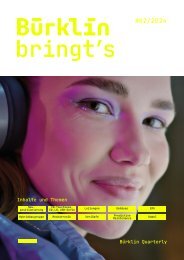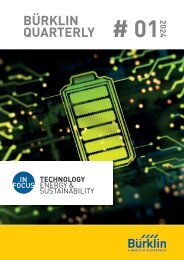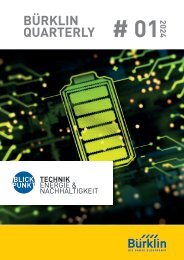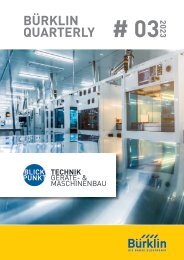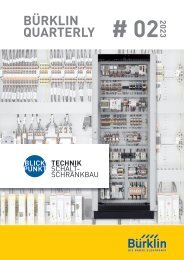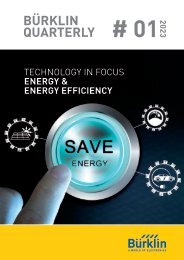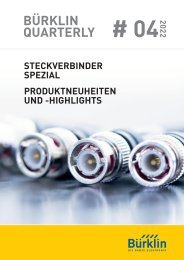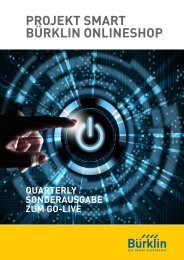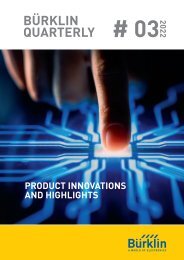Bürklin Elektronik Quarterly # 04/2021 Englisch
Bürklin Quaterly is a Bürklin Elektronik magazine published four times a year with profound information on services, products and manufacturers.
Bürklin Quaterly is a Bürklin Elektronik magazine published four times a year with profound information on services, products and manufacturers.
You also want an ePaper? Increase the reach of your titles
YUMPU automatically turns print PDFs into web optimized ePapers that Google loves.
HAMMOND ELECTRONICS<br />
TOP TIPS WHEN SPECIFYING<br />
SMALL ELECTRONIC ENCLOSURES<br />
Your new project has been designed, prototyped, debugged, tested, tweaked, tested again and finally<br />
signed off for production. In the ideal world, the enclosure would have been selected far earlier in the<br />
process, but the first question after design finalisation is normally, “what size box do I need?”<br />
1. SIZE<br />
How big is the PCB? Is it to be mounted<br />
horizontally or vertically? Many<br />
plastic enclosures have slots in the<br />
sides for direct vertical mounting<br />
and mounting bosses in the top and<br />
base for horizontal mounting. Extruded<br />
aluminium enclosures will often<br />
have slots in the sides for horizontal<br />
PCB mounting. How much space<br />
does there need to be on the faces<br />
for indicators, switches, connectors,<br />
cable entries and similar components?<br />
What height is required for<br />
board-mounted components or<br />
multiple horizontal boards?<br />
2. INSTALLED ENVIRONMENT<br />
Will the product be used inside or<br />
outside? Will the ingress of dust and<br />
water be something to be considered<br />
– see Point 4 below. Are there likely<br />
to be contaminants present – oils,<br />
chemicals and so on. Is impact resistance<br />
a consideration? If so, metal<br />
enclosures are better than plastic<br />
ones. Are particularly high or low<br />
temperature expected?<br />
3. MATERIAL<br />
For small enclosures, the choice is<br />
mainly between ABS or polycarbonate<br />
plastic, aluminium and GRP.<br />
For outside installation, polycarbonate<br />
or GRP are the default choices<br />
for UV stability. Fire resistance is a<br />
consideration; the relevant standard<br />
is UL94, which specifies a vertical<br />
or horizontal burn. The more stringent<br />
test is the vertical burn test;<br />
material will be classified as V0, V1<br />
or V2 where V0 is the highest performance.<br />
Aluminium enclosures are either<br />
die-cast or extruded. Both are robust<br />
and give good impact resistance,<br />
they do not corrode and are electrically<br />
conductive and are easily machined.<br />
With a suitable gasket fitted<br />
between the lid and the base, sealing<br />
to IP68 can be easily achieved.<br />
4. EMC<br />
Plastic enclosures have one specific<br />
weakness: they offer no EMC attenuation.<br />
If EMC is a potential problem,<br />
internal coatings in a variety of<br />
materials can be applied to a plastic<br />
enclosure to give different degrees<br />
of attenuation.<br />
Metal enclosures, providing that<br />
there is electrical continuity between<br />
the top, base and removable panels,<br />
will provide an attenuation level suitable<br />
for the majority of commercial<br />
applications.<br />
5. ENVIRONMENTAL SEALING<br />
The relevant international standard<br />
is EN 60529, which defines ratings<br />
written as IPxx, where the first digit<br />
defines the protection against solid<br />
objects and the second the protection<br />
against water ingress.<br />
Typically, IP54 enclosures are suitable<br />
for general purpose use; for<br />
installation in environments where<br />
dust and water are likely to be present,<br />
IP66, 67 or 68 would be specified.<br />
The highest rating is IP69K,<br />
which gives protection against steam<br />
cleaning at high pressure.<br />
SOLID OBJECT PROTECTION CLASSES<br />
First Scope of protection<br />
Figure<br />
0 No protection.<br />
1 Protection against solid objects > 50mm.<br />
2 Protection against solid objects > 12.5mm.<br />
3 Protection against solid objects > 2.5mm.<br />
4 Protection against solid objects > 1.0mm.<br />
5 Protection against dust ingress in harmful quantities.<br />
6 Dust tight.<br />
PROTECTION CLASSES FOR WATER PROTECTION<br />
Second Scope of protection<br />
Figure<br />
0 No protection.<br />
1 Protected against vertically falling drops of water.<br />
2 Protection against falling water drops up to 15° from the vertical.<br />
3 Protected against direct water sprays from up to 60° from the vertical.<br />
4 Protected against splashing water from any direction.<br />
5 Protection against low pressure 6.3mm jets of water from any angle.<br />
6 Protection against powerful 12.5mm water jets from any angle.<br />
7 Protection against temporary immersion in water up to 1 metre deep.<br />
8 Protection against continuous immersion in water greater than<br />
1 metre in depth.<br />
9K Protection against high-pressure, high-temperature jet sprays,<br />
wash-downs or steam-cleaning procedures.<br />
For example: IP68 is totally dust tight and suitable for continuous immersion in water<br />
greater than 1 metre in depth.<br />
6. APPEARANCE/STYLING<br />
Plastic enclosures offer a choice of<br />
opaque and translucent material in<br />
a variety of colours, they can also be<br />
moulded in a transparent material;<br />
styled lids have recesses for membrane<br />
keypads and displays. Aluminium<br />
enclosures can be painted or<br />
anodised in different colours.<br />
7. DISTRIBUTOR TECHNICAL<br />
SUPPORT<br />
Distributors keep extensive stocks<br />
of standard enclosures on the shelf,<br />
and they are now joining manufacturers<br />
in providing technical support to<br />
their customers at the design stage<br />
to help specify the most appropriate<br />
enclosure.<br />
8. DOWNLOADABLE DRAWINGS<br />
Typical downloadable resources include<br />
dimensioned drawings in PDF<br />
and CAD formats to assist with design<br />
and modification requirements,<br />
technical details and key product<br />
attributes.<br />
9. SUMMARY<br />
At first glance a small enclosure<br />
may seem to be a simple box, but in<br />
reality, it is the result of a great deal<br />
of design effort that has created a<br />
feature-rich housing suitable for use<br />
in a wide variety of environments.<br />
From: RUSSELL IRVINE<br />
28 Bürklin <strong>Quarterly</strong><br />
www.buerklin.com<br />
29





